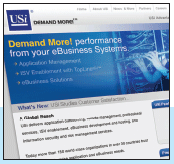Who's Who Profile: USi

by Peter Devereaux
07 Aug, 2006
 |
There comes a time for every successful Web businesses when outsourcing application development is considered. There are many benefits to outsourcing (reduced personnel costs, broader network availability, flexibility and capital savings) and new systems are gaining in popularity with midmarket companies. Website Services Magazine queried USi, a leading ASP and WSM Who's Who on the technologies, risks and rewards of outsourcing. |
WSM: What technologies are changing the way software is managed, and how will they impact vendor outsourcing?
USi: In today's application market, there is greater interest in delivering IT as needed-having the ability to dial up or dial down on demand.
The IT-as-needed model is changing the way clients define IT return on investment and demonstrated value. This market demand for flexibility is particularly challenging to software vendors, who now are forced to change the way they've traditionally licensed software and assessed its value. Long-term, perpetual licenses with annual maintenance and pricing based on numbers of users do not support the current market demand. The market is forcing software vendors to consider new license models or delivering their software in the Software-as-a-Service (SaaS) model.
USi has invested heavily in developing technology that meets these demands. The USi Pinnacle On-Demand Platform & USi's Flex Advantage Service Model are examples of dial up/dial down technology and service capabilities provided by top tier outsourcers.
WSM: How are customers balancing the risks and benefits of traditional versus hosted application management?
USi: Today's outsourcing customer must be an educated consumer. Outsourcing contracts must be structured with the success of the overarching business in mind. Service Level Agreements that tie to business objectives, system performance or service provider response are needed; as opposed to the traditional "standard availability" guarantees of the past.
By establishing a true partnership with our clients, USi seeks to become a trusted advisor. We aim to educate our customers by looking at how their business integrates with its technology.
Gartner Research recently conducted a survey to determine where clients feel dissatisfied with application outsourcing. The biggest drawback was a lack of understanding of the client's business goals. When we invest in a relationship at the beginning, we mitigate this potential roadblock and we can tie our Service Level Agreements to tangible business results for specific clients. These Service Level Agreements are less about technology, but more focused on performance, which is paramount to the end user.
WSM: What are the synergies between hosted and traditional application management services?
USi: Enterprises worldwide are successfully managing their application portfolios in-house. However, the most time-consuming and expensive applications are typically not core to their business; still, they are a necessary asset.
Working with the right vendor can allow a potential client to determine which applications should remain in-house while defining ways to outsource others. The outsourced set of applications are managed much like an internal IT department, but the vendor can typically manage at a lower cost with a higher level of performance.
When we work closely with our clients to establish a strong understanding of roles, responsibilities and expected results of outsourcing, we're seen as an extension of internal IT.
WSM: How can vendors and service providers use hosted application management to help meet the needs of mid-market companies?
USi: IT assets are critical but often difficult to invest in for the mid-market. Vendors that host applications for multiple tenants can invest in the technology and provide a higher level of service than most mid-market companies could do on their own. Our model allows those companies to have the availability as well as performance gains, features and functionality usually seen at the higher end of the market at a lower cost. It's essentially an enterprise-class system without an enterprise-class price tag.
By offering clients the education they need to understand what we do and how we do it, our clients find that they are much happier with an outsourcing agreement than they anticipated. -

Peter Devereaux
As the Editor-in-Chief of Website Magazine and President of Website Services, Peter has established himself as a prominent figure in the digital marketing industry. With a wealth of experience and knowledge, Peter has been a driving force in shaping the landscape of digital marketing. His leadership in creating innovative and targeted marketing campaigns has helped numerous businesses achieve their revenue growth goals. Under his direction, Website Magazine has become a trusted source of information and insights for digital marketers worldwide. As President of Website Services, Peter oversees a team of talented professionals who specialize in SEO/SEM, email marketing, social media, and digital advertising. Through his hands-on approach, he ensures that his team delivers exceptional results to their clients. With a passion for digital marketing, Peter is committed to staying up-to-date with the latest industry trends and technologies, making him a sought-after thought leader in the field.
Subscribe to Our Newsletter!
Latest in Marketing








